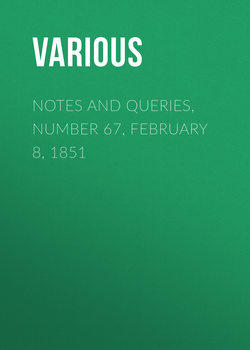Читать книгу Notes and Queries, Number 67, February 8, 1851 - Various - Страница 3
Notes
FOLK LORE
ОглавлениеLammer Beads (Vol. iii. p. 84.).—If L. M. M. R. had taken the trouble to consult Jamieson's Etymological Dictionary,—that rich storehouse of curious information, not merely in relation to the language, but to the manners and customs, and the superstitions of North Britain,—he would have found interesting notices connected with his inquiry. See the word Lammer, and the same in the Supplement. We might accept, without a moment's hesitation, the suggestion of a learned friend of Dr. Jamieson's, deriving Lammer from the French, l'ambre, were it not that Kilian gives us Teut. Lamertyn-steen, succinum. In Anglo-Saxon times it was called Eolhsand (Gloss. Ælfr.), and appears to have been esteemed in Britain from a very early period. Amongst antiquities of the Anglo-Saxon age, beads of amber are of very frequent occurrence. Douglas has collected some interesting notes regarding this substance, in his Nenia, p. 9. It were needless to cite the frequent mention of precularia, or Paternosters, of amber, occurring in inventories. The Duke of Bedford, Regent of France, purchased a most costly chaplet from a Parisian jeweller, in 1431, described as "une patenostres à signeaux d'or et d'ambre musquet." (Leber, Inventaires, p. 235.) The description "de alba awmbre," as in the enumeration of strings of beads appended to the shrine of Sr William, at York Minster, may have been in distinction from jet, to which, as well as to amber, certain virtuous or talismanic properties were attributed. There were, however, several kinds of amber,—succinum rubrum, fulvum, &c. The learned professor of Copenhagen, Olaus Worm, alludes to the popular notions and superstitious use of amber—
"Foris in collo gestatum, contra fascinationes et nocturna terriculamenta pueros tueri volunt; capitis etiam destillationibus, et tonsillarum ac faucium vitiis resistere, oculorum fluxus et ophthalmias curare."
By his account it would seem to have been received as a panacea, sovereign for asthma, dropsy, toothache, and a multitude of diseases.
"In summâ (he concludes) Balsami instar est, calorem nativum roborans et morborum insultibus resistens."—Museum Wormianum, p. 32.
Bartholomaeus Glanvilla, in his work, De Proprietatibus Rerum, has not overlooked the properties of amber, which he seems to regard as a kind of jet (book xvi., c. xlix.).
"Gette, hyght Gagates, and is a boystous stone, and never the les it is precious."
He describes it as most abundant and of best quality in Britain of two kinds, yellow and black; it drives away adders,—
"Is contrary to fendes,—helpeth for fantasies and ayenste vexacions of fendis by night.—And so, if so boystus a stone dothe so great wonders, none shuld be dispisid for foule colour without, while the vertu that is within is unknowe." (Translation by Trevisa.)
Albert Way.
